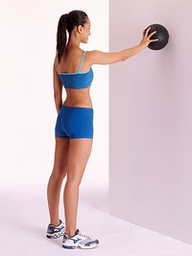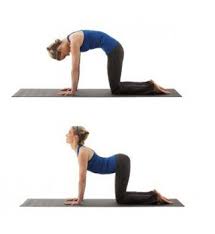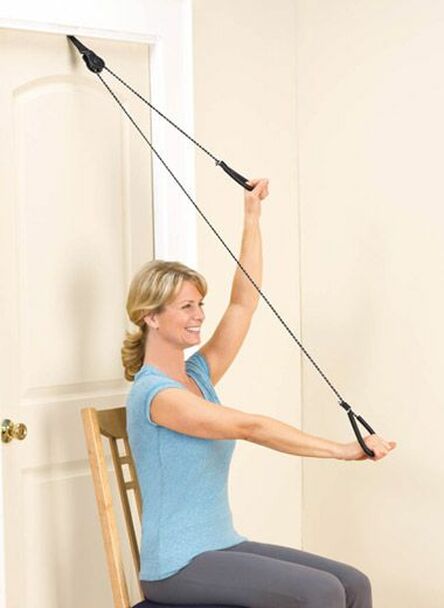Serratus anterior strengthening exercise: Health Benefits, How to Do?
Serratus anterior strengthening exercise is a best option to improve function of your shoulder girdle and also helps to up your fitness level and stamina.
What is the Serratus anterior strengthening exercise?
The serratus anterior muscle originated from your shoulder blade (scapula) to your rib cage. These muscles are known as “the boxer’s muscle and big swing muscle. This muscle aids with shoulder movement. It is situated in the upper back below the shoulder blades, along the thoracic wall, and on the surface of the middle border of the scapula. serratus anterior primary function is to assist with the upward rotation of the scapula.
Dysfunction of this muscle may cause scapular winging, a rare condition in which the shoulder blade is pulled away from the thoracic line, making upper-limb movements difficult. Serratus anterior strengthening exercises are designed to fortify weak serratus anterior muscles and can help to prevent winged scapula.
Health Benefits of Doing Serratus Anterior Exercises:
- These exercises can help to improve overhead mobility. Reaching above your head is necessary for a variety of athletic movements as well as daily activities.
- This muscles activation improves protraction and flexion of the shoulder muscles for improved scapular stabilization and thoracic spine mobility.
- Serratus anterior exercises can help to improve shoulder health. A weak serratus anterior can lead to back pain and shoulder pain—especially in the rotator cuff tendons. Regular activation of the serratus anterior can help to build strong shoulder muscles and healthy shoulder joints.
- These exercises can help you to prevent injury. A strong serratus anterior can help prevent shoulder impingement and rotator cuff tear.
- Helps to reduce the Serratus anterior pain related condition
Serratus Anterior Exercises You Can Do at Home.
Bear crawls
How to do it?
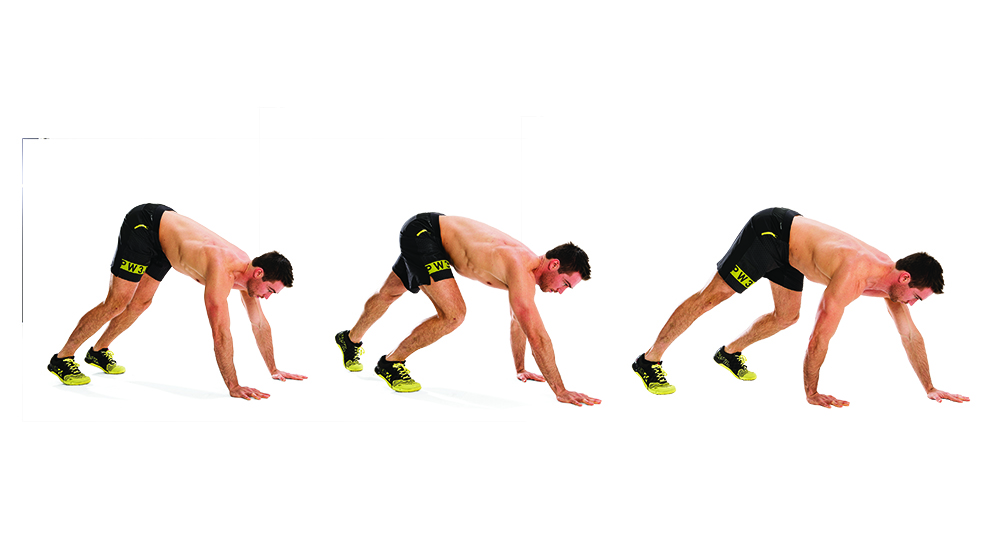
- This is a body weight mobility exercise that can increase your heart rate, burn calories, and build your core muscle strength.
- To perform the bear crawl, put your hands and feet on the ground shoulder-width apart with your body face down.
- Crawl forward with an alternating motion pattern, moving your left leg as you move your right arm and your right leg as you move your left arm.
- With proper form and regular practice, bear crawls can build your upper- and lower-limb strength.
Scapular push-ups
How to do it?

- This exercise is Also known as the push-up plus or scapular push-ups. This can be used as a small range of motion to strengthen the scapular muscles.
- To practice this exercise, you have to begin with the standard push-up position or high plank position.
- Your back should be in a straight line and without flexing your elbows, slowly squeeze your shoulder blades together and apart to move your upper limb up and down slightly.
Scapular pull-up
How to do it?
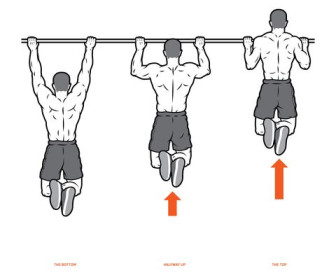
- This exercise includes the upper-body workout that uses a smaller range of motion than a regular pull-up to activate your shoulder muscles and back muscles.
- When you do it properly, scapular pull-ups lead to increased upper-limb strength. The primary muscle groups targeted by scapular pull-ups are the lattisimus dorsi, trapezius, rhomboids, and serratus anterior muscles.
- To do a scapular pull-up, begin with a dead hang position with your elbows slightly flexed.
- Do a reverse shrug to contract your shoulder blades together and slightly lift your body upwards.
- Hold at the top position before you lower back to the initial position.
Dumbbell pullover
How to do it?
- This is a weightlifting exercise that targets your pectoralis and lattisimus muscles.
- Do this exercise by holding a single dumbbell and lying back on a flat bench. your lower back should be in contact with the bench and engage your core.
- To extend the arms, extend the dumbbell above your chest.
- Carefully lower the dumbbell behind your head before returning it to the initial position above you. Repeat this for 2nto 3 sets of 10 to 15 repetitions.
Wall slides
How to do it?
- To do wall slides, you have to stand upright with your feet shoulder-width apart and your back flat against a wall. elevate your arms against the wall and flexed your elbows at a ninety-degree angle.
- The line from your armpit to your elbow should be parallel with the ground. Your posterior aspect of your hands should be touching the wall. Slowly flex your knees, maintaining contact with the wall, until your knees are flexed at a forty-five-degree angle.
- While flexing your knees, straighten your arms so that they are completely straight above your head. Hold for 5 seconds at the bottom of the movement.
- Return to the initial position and repeat for the desired amount of repetitions.
Band pull-apart
How to do it?
- This exercise is an isolation exercise that is designed to target your shoulder muscle groups and upper back.
- By building upper limb strength and stability, band pull-apart can prepare you for more challenging compound exercises like bench presses, pull-ups, and dead lifts.
- Do band pull-apart by holding a resistance band with a shoulder-width grip. Keep your arms straight as you pull the resistance band laterally, extending both arms to either side.
Clockwise Arm Swings
How to do it?
- If you want to strengthen your serratus anterior muscle then begin with doing arm swings.
- This will stimulate the muscles of your chest, including your pectoral, clavicular, and deltoid muscles.
- To perform this exercise, elevate your arms up to shoulder height and swing them back and forth as high as possible, going from one side to the other. Repeat 20 to 30 times. Make sure your arms are extended and shoulder blades are retracted.
- When you are doing this exercise, make sure to keep your shoulders back.
Rhomboid Pull
How to do it?
- These is the best exercises to improve your serratus anterior strength.
- Firstly, stand with your feet shoulder-width apart. Raise your arms to the shoulder height and parallel to the ground.
- Flexed your elbows, pull your elbows back, and contract your shoulder blades.
- Return and repeat. breath out when pulling back, and breath in when you return. Make sure your arms are parallel to the ground. Keep your triceps contracted. Perform three sets of 15-20 repetitions.
Wall Push-up
How to do it?
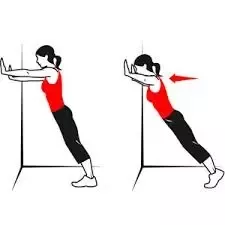
- For this exercise you have to Stand about two feet away from a wall, then put your palms on the wall and walk your fingers up until they reach eye level.
- Flexed your elbows and lean forward from the trunk until you feel a good stretch in your chest and shoulders, but not so much that it becomes painful.
- Now, push yourself away from the wall to complete one repetition of this exercise.
- This exercise is the same as standard pushups, except your hands are placed on top of a wall or other elevated surface. This extra leverage will place more emphasis on the serratus anterior muscles, which lie just beneath the pectorals.
Russian Twist
How to do it?
- This is a great exercise for the serratus anterior muscles.
- For this exercise, you have to Sit with your feet slightly lifted and back tilted backward.
- Hold your hands together and twist from side to side. breath out as your twist. Keep your legs still when twisting. your neck should be neutral. Tighten your abdominals. Do this for 40 seconds. Make sure you are not moving your legs.
- If you can not hold your legs steady, put them on exercise balls.
Long Arm Crunches
How to do it?
- This exercise will help to tone your abdominal muscles and your serratus anterior, which elevate your shoulders. for this exercise you have to Lie on your back with your feet flat on the ground.
- Stretch your arms over the top of your head. Put one hand on top of the other. lift your shoulders off the ground, then slowly go back down. Use your abdominal muscles. breath out as you lift your shoulder, and breath in when you lower them.
- Do this for 30 to 40 seconds. You can also perform this on an exercise ball.
Serratus Punch
How to do it?
- This exercise strengthens the serratus anterior, this is also known as the chest wall muscle, which in turn helps to shape your pectoral muscles in a way that you can increase your upper-limb muscle’s strength.
- For this exercise you have to stand with your back towards the pulley or elastic band device, knees slightly flexed, and feet apart in a split stance.
- The handle of the pulley or resistance band is then held at shoulder height with the elbow fully extended, the humerus internally rotated forty-five degrees, and the scapula in a retracted position.
- Then a protracted and retracted scapula movement is being made in a direction of 120 degrees because Serratus Anterior activity tends to increase in a somewhat linear fashion with arm elevation. Lastly, repeat with the other hand.
Band Chest Presses
How to do it?
- This exercise targets the serratus anterior, which is located at the side torso.
- Serratus anterior is responsible for stabilizing your scapula and also helps to push up your arms during a push-up.
- You have to take a supine lying position withholding a resistance band at the bottom of your chest.
- Then, slowly raise your arms until they are fully extended. Your elbows should stay close to your sides.
- Hold for 5-7 seconds before slowly lowering back to the initial position. Do 2 to 3 sets of 10-15 repetitions for this exercise.
Side Plank
How to do it?

- This exercise will help to strengthen your serratus anterior and helps you to improve endurance in your core.
- For this exercise you have to Lie on your left side, keeping your elbow slightly flexed on the edge of the ground with the palm of your hands on top of each other. Keep sure you are stacked towards one shoulder so that toes are facing down on one side and upon the other.
- Raise your hips off the ground and hold for 30-40 seconds, making sure to keep your body in a straight line.
- Do 2 sets of 10-15 repetitions for this exercise.
- So, now you know what are serratus anterior exercises. Always consult your doctor before performing any exercise. There are many more exercises that can be performed to strengthen your serratus anterior.
- The important thing is that you keep working out the muscles in this area with these 8 specific movements. You will be amazed at how your body will develop after a few weeks of performing these simple moves.
Scapular Plane Lateral Raises
How to do it?
- This variation of exercise will work in the scapular plane about twenty to thirty degrees in front of your trunk.
- Angle your arms out this way and also open up your shoulder blades a bit more so that your serratus are under a bit more tension.
- The arms are at a slight angle when you are raising the dumbbells, which will still work the lateral deltoid and serratus anterior while slightly reducing the strain on your rotator cuff tendons.
- If you have beat-up shoulders, this is the exercise for you to strengthen your serratus anterior.
Dumbbell Rotational Punches
How to do it?
- Mostly Fighters have typically well-developed serratus (and abs in general) because they are consistently extending their arms (and so protracting and retracting their shoulder blades) and rotating to punch.
- The good news for you is that you do not need to step into the cage to achieve the same results.
- But Just pick up a pair of light dumbbells, and, with control, rotate and punch.
- You will improve your conditioning and activate your abdominals and serratus.
How to Work Out Safely and Avoid Injury?
- If you have a previous or pre-existing health condition, then consult your doctor before starting an exercise program. Proper form is important to ensure the safety and effectiveness of an exercise program, but you may need to modify each exercise to attain optimal results based on your individual needs. Always select a lightweight that allows you to have full control of your movement. When doing any exercise, pay close attention to your body, and stop immediately if you feel pain or discomfort.
- To see continual progress and build body strength, do proper warm-ups, rest, and nutrition in your exercise program. Your results will ultimately be based on your ability to adequately recover from your workouts. Rest for 20 to 40 hours before training the same muscle groups to allow sufficient recovery.
When did you not do these exercises?
- If your arm bone and scapula are recently fractured.
- If you feel any pain during these exercises.
- If your doctor advised you to take a rest.

